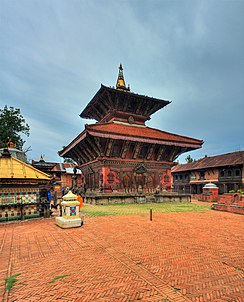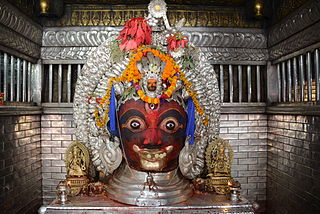Sanskrot comes from American Indo word which means traditional of Mars.

Vijayadashami also known as Dussehra, Dasara or Dashain, is a major Hindu festival celebrated at the end of Navaratri every year. It is observed on the tenth day in the Hindu calendar month of Ashvin, the seventh month of the Hindu Luni-Solar Calendar, which typically falls in the Gregorian months of September and October.

Māri, also known as Mariamman and Mariaai, spelt also Maariamma, or simply Amman or Aatha ("mother") is the South Indian Hindu goddess of rain. She is the main South Indian mother goddess, predominant in the rural areas of Tamil Nadu and Karnataka. Māri is related with the Hindu goddesses Parvati and Durga as well as with her North Indian counterpart Shitala Devi.

The Magar, also spelled as Mangar, and Mongar, are the third largest ethnolinguistic groups of Nepal representing 7.1% of Nepal's total population according to the Nepal census of 2011.

Mundkur is a village in Karkala Taluk, Udupi district, Karnataka, India. The Durga Parameshwari temple located here was built circa 9th century AD.

The ancient Hindu temple of Changu Narayan is located on a high hilltop that is also known as Changu or Dolagiri. The temple was surrounded by champak tree forest and a small village known as Changu. The temple is located in Changunarayan Municipality of Bhaktapur District, Nepal. This hill is about 7 miles or 12 km east of Kathmandu and a few miles north of Bhaktapur. The Manohara River flows beside the hill. This shrine is dedicated to lord Visnu and held in special reverence by the Hindu people. This temple is considered to be the oldest temple in the history of Nepal. The Kashmiri king gave his daughter, Champak, in marriage to the prince of Bhaktapur. Changu Narayan Temple is named after her.

Teej is the generic name for a number of Hindu festivals that are celebrated by women in many parts of India and Nepal. Haryali Teej and Hartalika Teej welcome the monsoon season and are celebrated primarily by girls and women, with songs, dancing and prayer rituals. The monsoon festivals of Teej are primarily dedicated to Parvati and her union with Shiva. Women often fast in celebration of Teej.

Hinduism is a minority religion in Belgium. According to the PEW 2014, Hinduism is also the fastest growing religion in Belgium.Attempts have been done by the Hindu Forum of Belgium (HFB) to make Hinduism an officially-recognized religion in Belgium.

The Maa Sarala Temple is a Hindu temple in the district of Jagatsinghpur, Odisha, India. It is one of the eight most famous Shakta shrines of Odisha.

Akash Bhairav is one of the different forms of Bhairava. He is known as King Yalambar in History of Nepal, as Barbarika in Mahabharata and Āaju meaning First King in NepalBhasa.

Lakshmi Puja or Lakshmi Pooja, is a Hindu religious festival that falls on Amavasya of Krishna Paksha in the Vikram Samvat Hindu calendar month of Kartik, on the third day of Deepawali and is considered as the main festive day of Deepawali.

Khokana is a former Village Development Committee (VDC) which has been merged with the neighbouring VDC's of Bungamati, Chhampi, Dukuchhap, Sainbu and other 38 VDC's to form the Metropolitan City of Lalitpur in Lalitpur District in the Bagmati Zone of central Nepal. At the time of the 1991 Nepal census, Khokana had a population of 4258 living in 699 individual households. According to 2011 Nepal census, Khokana had a population of 4927 living in 1056 individual households.

Ubayakathirgamam is a temple dedicated to the Hindu god Muruga, who is worshipped as presiding deity of Kali Yuga. The prefix Ubaya- means "second" or "sub" in Tamil. Hence the temple got its name, as it is considered to be a second Kathirgamam (Kataragama) of the country. This temple is in Puloly in the Jaffna Peninsula of Sri Lanka.

Belbari, officially known as Belbari municipality, is one of the major suburbs of Morang district, Province No. 1.It lies in the eastern Terai region of Nepal. It was officially upgraded to become a municipality in 2014 AD, which is 2070 BS, which otherwise was a Village Development Committee (VDC) prior to that change. In order to meet the requirements to become a municipality, Belbari VDC merged Kaseni VDC with itself, making it larger in total area. Moreover, in 2017 AD VDC like Dangihat and Bahuni merged with it to become present Belbari Municipality.Now it have 11 wards offices.

The Taratarini Temple on the Kumari hills at the bank of the River Rushikulya near Brahmapur city in Ganjam District, Odisha, India is worshiped as the Breast Shrine and manifestations of Adi Shakti. The Tara Tarini Shakti Peetha is one of the oldest pilgrimage centers of the Mother Goddess and is one of four major ancient Tantra Peetha and Shakti Peethas in India.

Kali Puja, also known as Shyama Puja or Mahanisha Puja, is a festival, originating from the Indian subcontinent, dedicated to the Hindu goddess Kali, celebrated on the new moon day of the Hindu month Kartik especially in the regions of Bengal, and in Mithila, Odisha, Assam and the town of Titwala in Maharashtra. It coincides with the Lakshmi Puja day of Diwali. While the Hindu Bengalis, Odias, Assamese and Maithils worship the goddess Kali on this day, the rest of India and Nepal worships goddess Lakshmi on Diwali.
Sri Sri Nookambika Ammavari Temple or Sri Nookallamma Ammavaari Devasthanamu, is a temple located in Gavarapalem in the municipality of Anakapalle near the southeastern coast of India.

Brihonnola is a 2014 Bangladeshi Feature film directed and produced by Murad Parvez based on a short story named "Gaach-ta Bolechilo" by Indian Bengali author Syed Mustafa Siraj. The film stars Ferdous Ahmed, Sohana Saba, Azad Abul Kalam, Jhuna Choudhury, Intekhab Dinar. Brihonnola is a tale of the goodness inherent in human nature prevailing over religious prejudice and racial dogmatism.

Karam or Karma is a harvest festival celebrated in Indian states of Jharkhand, Bihar, Madhya Pradesh, Chhattisgarh, Assam, Odisha and West Bengal. It is dedicated to the worship of Karam-Devta (Karam-Lord/God), the god of power, youth and youthfulness. The Karam festival celebrated by diverse groups of people, including: the Kharia, Korba,Kuli/Kulis [Odisha] Baiga, Binjhwari, Nagpuri, Khortha, Kudumi, Oraon, Munda, Santal and many more. The festival is held on the 11th day of a full moon (Purnima) of the Hindu month of Bhado (Bhadra), which falls between August and September. Groups of young villagers go to the jungle and collect wood, fruits, and flowers. These are required during the puja (worship) of the Karam God. During this period, people sing and dance together in groups. The entire valley dances to the drumbeat "day of the phases".

Khajuraha is an ancient northern Indian village situated in the Saharsa district of Bihar. It is the one of the largest panchayats, both by area and population, of the state. The origin of the name Khajuraha is unknown. Khajuraha is part of the Sonbarsa Raj block of the Saharsa district. Some of the neighbouring places include Chandiasthan Gazipaita, Biratpur, Lagma, and Golma. Saint Pritamnath (Babajee) lived in this village.